#staatliche kunstsammlungen dresden
Text

© Albertinum | GNM, Gal.-Nr. 2219 C Staatliche Kunstsammlungen Dresden, Foto: Jürgen Karpinski prozession im nebel
#art#painting#ernst ferdinand oehme#albertinum galerie neue meister#staatliche kunstsammlungen dresden#prozession im nebel
127 notes
·
View notes
Photo
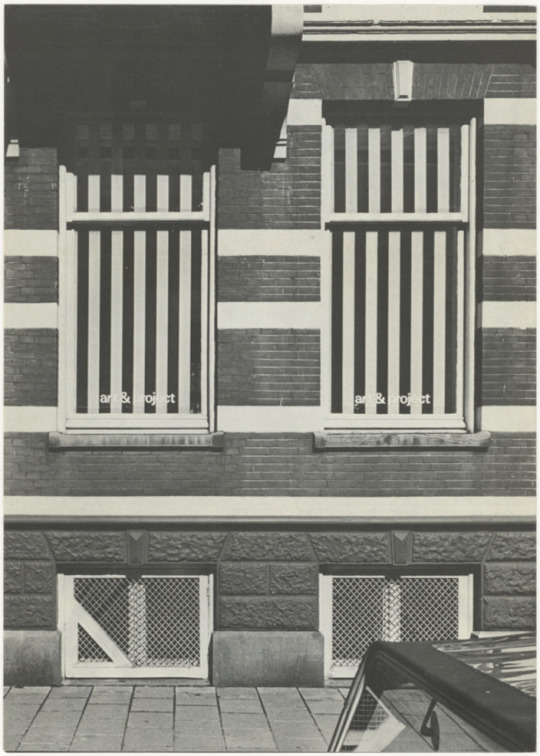
«Bulletin» 76, Daniel Buren: Transparency, Art & Project, Amsterdam, [April 18], 1976 [two photo-souvenire, March 26, 1974] [Sammlung Marzona, Kunstbibliothek – Staatliche Museen zu Berlin; VG Bild-Kunst, Bonn. AdA Invitations, Archiv der Avantgarden (AdA), Staatliche Kunstsammlungen Dresden, Dresden. MACBA, Barcelona. RKD – Nederlands Instituut voor Kunstgeschiedenis, Den Haag. © Daniel Buren]
#graphic design#art#photography#geometry#pattern#brochure#daniel buren#bulletin#sammlung marzona#staatliche museen zu berlin#ada invitations#archiv der avantgarden#staatliche kunstsammlungen dresden#macba#nederlands instituut voor kunstgeschiedenis#1970s
38 notes
·
View notes
Text

Caricature of Napoleon: “The Parisian Nutcracker”
1813-1814
#Napoleon-Karikatur: Der Pariser Nussknacker (Napoleon beißt sich an der harten Nuss der Schlacht zu Leipzig 1813 die Zähne aus)#print#napoleonic era#napoleon#napoleon bonaparte#first french empire#french empire#napoleonic#19th century#french revolution#history#coalition propaganda#propaganda#caricature#German#Leipzig#Staatliche Kunstsammlungen Dresden#SKD#Dresden
15 notes
·
View notes
Text
DEUTSCHES DESIGN 1949–1989. zwei Länder, eine Geschichte: Wien bis 14.01.2024
Das deutsche Design erlangte in den 1920er Jahren dank der Bauhausschule und des Werkbundes große Bedeutung. Nach der Teilung Deutschlands im Jahr 1949 gingen Design und Alltagskultur jedoch auf beiden Seiten der Grenze getrennte Wege. Im Westen spielte das Design eine wichtige Rolle im Wirtschaftswunder, während es im Osten in die sozialistische Planwirtschaft integriert wurde.
Die Ausstellung…
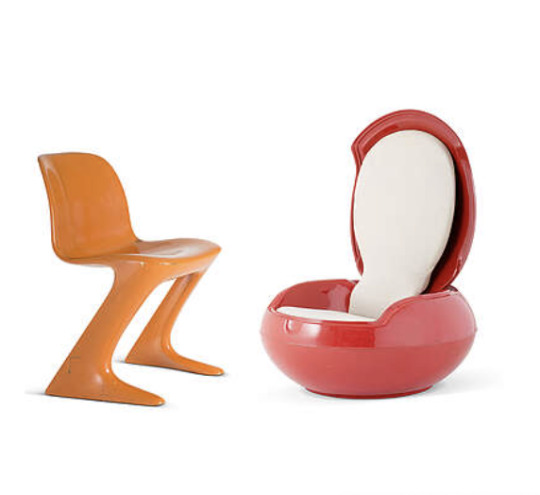
View On WordPress
#Bauhaus#Design#Handwerkskunst#Kunstgewerbemuseum#Möbel#Museum für Kunst & Gewerbe Hamburg#Planwirtschaft#Staatliche Kunstsammlungen Dresden#Vitra Design Museum#Werkbund#Wiener Möbelmuseum#Wirtschaftswunder
2 notes
·
View notes
Text
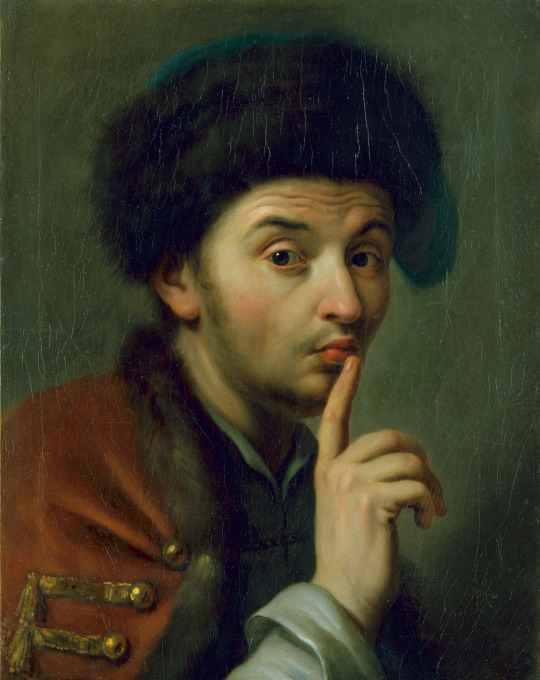
Pietro Antonio Graf Rotari - Men With Fur Hat, Lifting His Right Index Finger
Gemäldegalerie Alte Meister, Staatliche Kunstsammlungen Dresden
#Pietro Antonio Graf Rotari#Men with fur hat#lifting his right index finger#Gemäldegalerie Alte Meister#Staatliche Kunstsammlungen Dresden
0 notes
Text
Gerhard Richter's Overpainted Photos

View On WordPress
#abstract#Dresden#Gerhard Richter#Overpainted Photographs#painting#the Albertinum at the Staatliche Kunstsammlungen
0 notes
Text
Where I find images to make into PNGs
Museum / collection websites
Rijksmuseum • Metropolitan Museum of Art • National Gallery of Art • The Walters Art Museum • Europeana • Public Domain Review • The British Library • Victoria & Albert Museum • Wellcome Collection • Risd Museum • Phoenix Ancient Art • Staatliche Kunstsammlungen Dresden • Georgian National Museum • Internet Archive • Getty Images • Louvre • Statens Historiska Muséer • Museum of Applied Arts • Royal Collection Trust • The Walters Art Museum • Science Museum Group • Kunst Historiches Museum Wien • The David Collection • MAK collection
+ pretty much any museum site with a virtual collection
Auction websites
1stDibs • Sothebys • Ruby Lane • Live Auctioneers • Christie’s • Timeline Auctions • Heritage Auctions • Auctionet • Hindman Auctions
Various
My pinterest • Worthpoint • Etsy • Shoplook • Wikimedia Commons • Replacements
Google reverse image search > “find image source” > “visually similar images”
Other PNG blogs
goobersplat • gooberscollage • vile-things • encyclopaedia-ornithonesiae • oceantoyz • transparensies • png-magician • whizpurr • adjpngs • transpareats • transparentstickers • transparenzz • pngtrash • fruit-prince • honeyrolls • bleedingthroughteeth • png-heaven
-
(I will be updating this list! If you have suggestions or would like to add or remove your blog from the list, message me)
#there are many more but this is a few of them#i've gotten so many asks about this so i thought a list might be fun#feel free to follow me on pinterest i just started using it more#link to it is under various#hope it helps#faq#png#pngs#moodboard#artboard#transparent#stickers#polyvore#shoplook#imageboard#collage
2K notes
·
View notes
Text
Steel Brocade: Puffed & Slashed Costume Armor
Surviving to this day in the collections of the world’s most illustrious museums are a group of three armors. These armors have much in common, but most striking is the attempts made by their armorers to render in steel a convincing portrayal of the puffed and slashed clothing fashionable to the early 16th century.
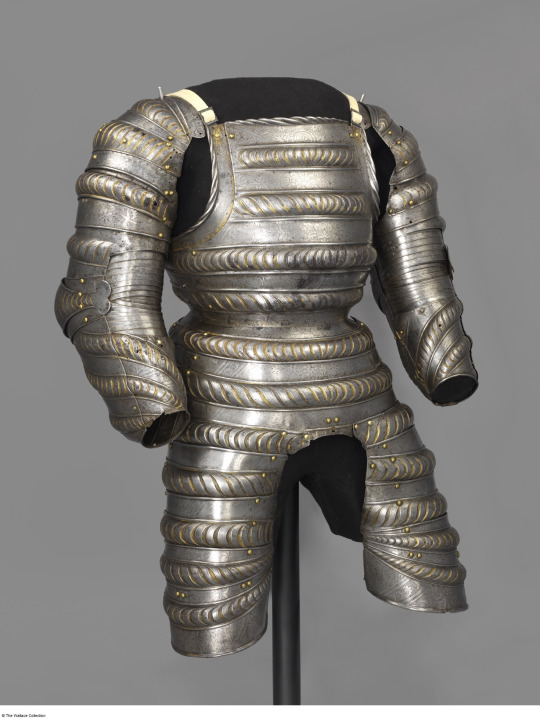


Though this fashion is synonymous with the landsknecht mercenaries who may have been responsible for popularizing it, the puffed and slashed style was enjoyed by members at all levels of society.

Portrait of Duke Henry of Saxony by Lucas Cranach the Elder, 1514, Staatliche Kunstsammlungen, Dresden.
The earliest of these three armors is housed at the Wallace Collection. Consisting only of a cuirass and arms, this armor is, at first glance, rather underwhelming when compared with the other armors in this group. Though the embossed bands styled with etched slashes embellished with gold provide the impression of a puffed and slashed doublet, the execution is all rather stiff, and lacks the impressive volume and fullness exemplified by the other armors.

It is for this reason that this armor, previously considered contemporary to the KHM and Metropolitan examples, has received relatively little attention. However, recent scholarship by Dr. Tobias Capwell suggests that this work is not, indeed, contemporary to the other examples, and is rather about ten years older, dating to ca. 1515. Dr. Capwell also considers this piece to be the work of Konrad Seusenhofer, a favored armorer of the Emperor Maximilian I.
Seen through this lens, not as a poorly executed contemporary of greater armors, but as a less developed ancestor to them, this armor takes on new life. It speaks to innovation and experimentation; an early attempt at a technique which would later be perfected.
The second in this line is the garniture of Wilhelm von Rogendorf, housed at the Kunsthistorisches Museum in Vienna.

This armor is unique for its condition, which is remarkably good. Not only does this armor retain more of its pieces than the other two, it is also accompanied by a number of “pieces of exchange,” elements which could be swapped out so the armor could be worn in the field.
Finished in 1523, as attested to by the date etched on the right shoulder strap, this armor was made for the Count Wilhelm von Rogendorf by Kolman Helmschmid and etched by Daniel Hopfer.

Wilhelm von Rogendorf himself was heir to a new, up-and-coming German noble family.

A medal showing Wilhelm von Rogendorf as a Knight of the Order of Calavatra, dated 1536, Kunsthistorisches Museum, Vienna.
Born in 1481 the second son of Kaspar von Rogendorf, Wilhelm became heir to his family’s estates when his elder brother Sigmund died in 1507, by which time Wilhelm was already a courtier at the Habsburg court. He entered into the service of King Charles I of Spain (later Emperor Charles V) no later than 1517 and was appointed Governor of Friesland. In 1522, Wilhelm accompanied Charles to Spain where he commanded a regiment of 4,000 landsknechts and was again placed in charge of a restless border territory. In 1524, he successfully captured the Fortress of Fuenterrabía from the French, which won him great praise from the Emperor. Shortly thereafter, Wilhelm was named Captain of the Imperial Bodyguard and given the governorships of Catalonia, the Cerdagne, and the Roussillon. Additionally, he was appointed to the Spanish chivalric Order of Calavatra. Wilhelm would retire from court in 1539, but would be recalled in 1541 to command Imperial troops against the Ottomans in Hungary. He would be killed later that same year at the siege of Buda by a stray cannonball.
Though Wilhelm’s armor is now displayed in its parade configuration, the surviving pieces of exchange attest to the fact that it was also an armor for combat. The cuirass is equipped with the long tassets common to the early 16th century. A pair of holes can be observed at the top of the last lame.

These holes correspond to holes at the top of the half-cuisses which accompany this armor, showing that these cuisses would be pointed to the tassets rather than worn separately.

In the rear, the cuirass is accompanied by a rump-defense, also known as a hoguine. Small turning pins near the waist allow this to be removed for combat.
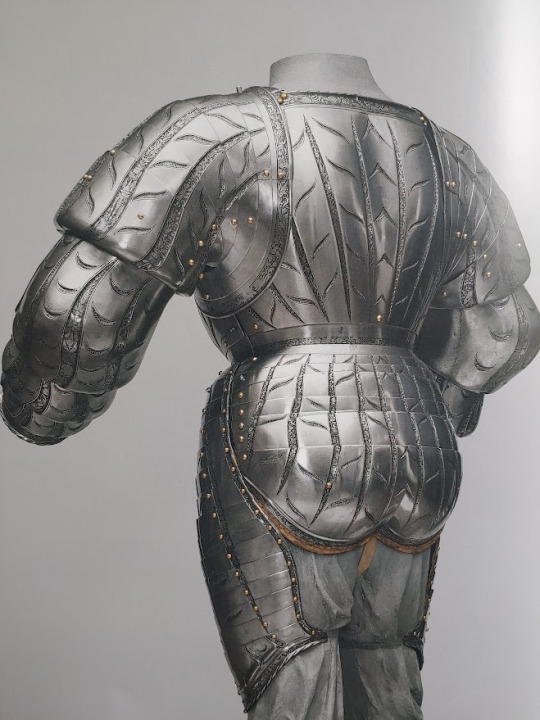
Both spaulders
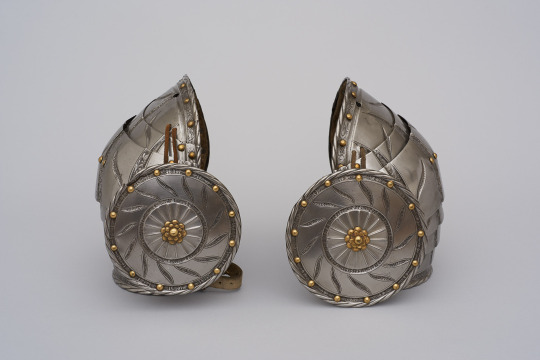
and gauntlets

survive. Additionally, the KHM retains the armor’s right vambrace

while the Wallace Collection holds the rerebrace and couter for the left arm.
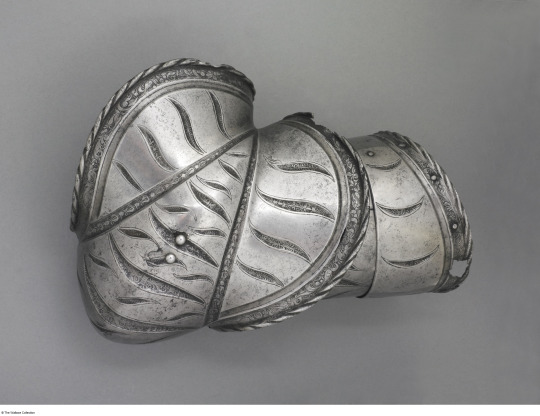
Recently, these pieces were assembled to show what the arm harness for field as a single unit would have looked like.
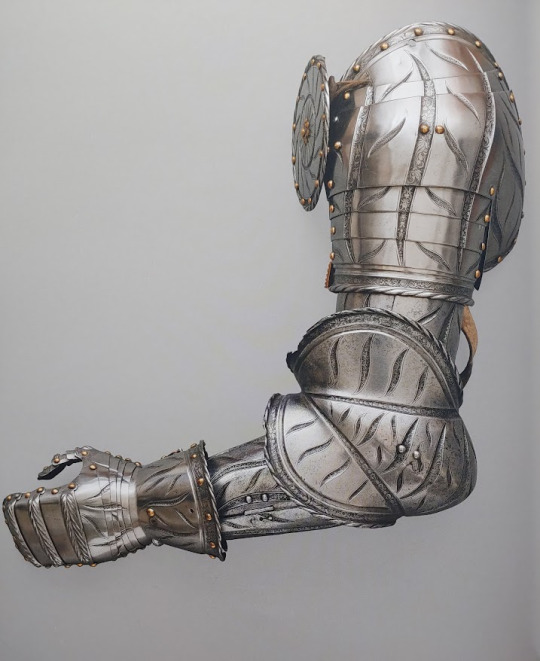
This armor would also have been accompanied by a gorget, now missing, and a helmet. Frequently, this armor is displayed alongside a close-helmet, however it is more likely the armor would have been accompanied by a burgonet similar in form to this example from the KHM.
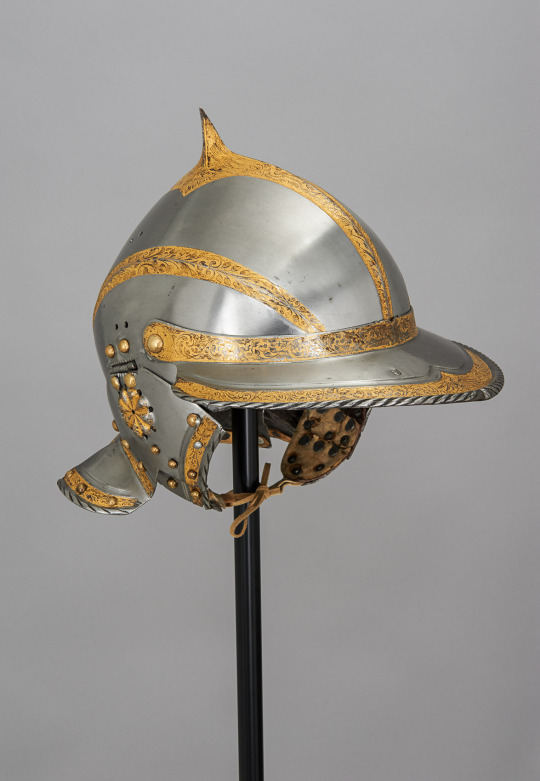
One final, unique surprise this armor holds is a hidden lance rest which is incorporated into the turned edge by the right arm. This rest folds down to allow a light lance to be braced atop it, and when folded up, is nearly invisible so as to not ruin the smooth surface of the breastplate with the prominent staples typically required for affixing a lance rest.

The third and final armor of this group is housed at the Metropolitan Museum of Art in New York City.

The least complete of these three armors, it may also be the most visually impressive. Comprised of only a backplate, hoguine, and arms, the puffs and slashes of this piece (also by Kolman Helmschmid and Daniel Hopfer) are ornately cusped. The slashed regions, displaying the gilded “fabric” beneath, and heavily etched to resemble an expensive silk brocade.
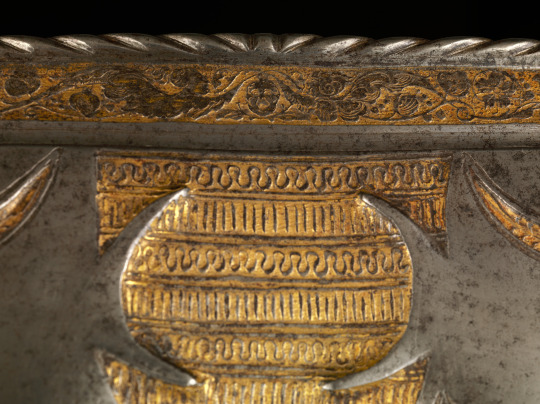
The sleeves of this armor are even more voluminous than those of the Rogendorf armor, though they are similarly articulated and provide the wearer with a surprising degree of mobility. It is thought that this armor may have been made for prominent Polish nobleman Jerzy Herkules Radziwill.
Interestingly, the hoguine of this armor is composed of two separate plates, rather than a single solid plate. Where the hoguine of the other two armors terminates in a decorative fabric border, the Met armor continues into two more articulated lames, covering the top rear of the thighs. Holes along the bottom edge suggest that this armor may have been accompanied by fully enclosing cuisses which pointed to the bottom of the fauld and hoguine.

Sources
“A Pair of Gauntlets.” Kunsthistorisches Museum Wien. https://www.khm.at/de/object/540164/.
“A Pair of Spaulders with Besagews.” Kunsthistorisches Museum Wien. https://www.khm.at/de/object/372772/.
Cranach, Lucas the Elder. “Portrait of Duke Henry of Saxony.” Staatliche Kunstsammlungen Dresden. https://skd-online-collection.skd.museum/Details/Index/246875.
Krause, Stefan. Fashion in Steel. Vienna: Kunsthistorisches Museum, 2017.
“Landsknecht Costume Armour.” Kunsthistorisches Museum Wien. https://www.khm.at/de/object/372771/.
“Left Upper Cannon and Couter.” The Wallace Collection. https://wallacelive.wallacecollection.org:443/eMP/eMuseumPlus?service=ExternalInterface&module=collection&objectId=60736&viewType=detailView.
“Open Burgonet.” Kunsthistorisches Museum Wien. https://www.khm.at/en/object/503346/.
“Parts of an Armour.” The Wallace Collection. https://wallacelive.wallacecollection.org:443/eMP/eMuseumPlus?service=ExternalInterface&module=collection&objectId=60519&viewType=detailView.
“Portions of a Costume Armor.” The Metropolitan Museum of Art. https://www.metmuseum.org/art/collection/search/27790.
“Vambrace.” Kunsthistorisches Museum Wien. https://www.khm.at/de/object/372773/.
“Wilhelm von Rogendorf.” Kunsthistorisches Museum Wien. https://www.khm.at/de/object/1409642/
.
#long post#armor#armour#landsknecht#costume armor#art#history#renaissance#germany#german#hre#holy roman empire#europe#european#themet#metmuseum#khm#skd#wallace collection
1K notes
·
View notes
Photo

Hunting bag (Schwedler) embroidered by Hans Erich Friese
Dresden, Germany, 1609
Staatliche Kunstsammlungen Dresden (via historicembroidery)
1K notes
·
View notes
Text
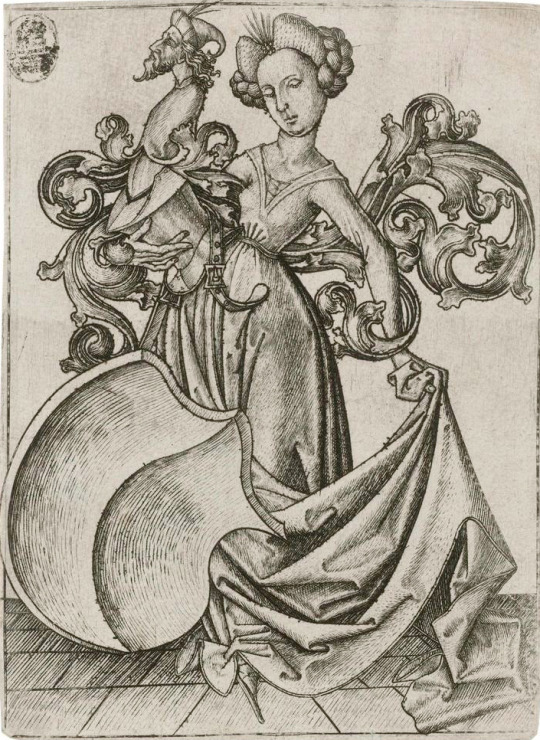
ab. 1450 Master E. S. - Lady with a helmet and an empty escutcheon
(Staatliche Kunstsammlungen Dresden)
82 notes
·
View notes
Photo

Georg Lührig / “Old age and youth” / probably 1898 / Staatliche Kunstsammlungen Dresden
228 notes
·
View notes
Photo
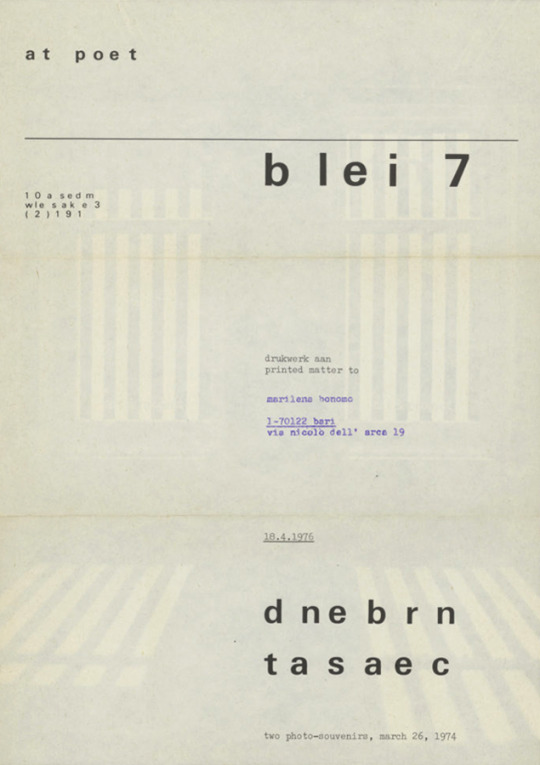
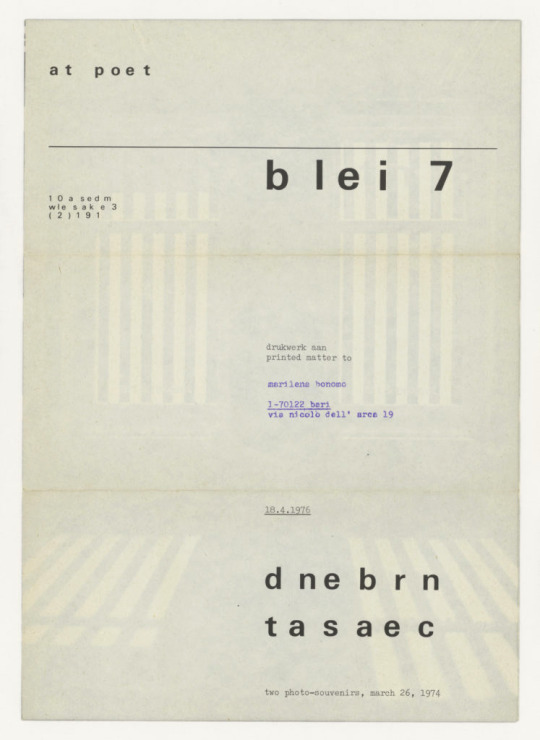

«Bulletin» 76, Daniel Buren: Transparency, Art & Project, Amsterdam, [April 18], 1976 [two photo-souvenire, March 26, 1974] [Sammlung Marzona, Kunstbibliothek – Staatliche Museen zu Berlin; VG Bild-Kunst, Bonn. AdA Invitations, Archiv der Avantgarden (AdA), Staatliche Kunstsammlungen Dresden, Dresden. MACBA, Barcelona. RKD – Nederlands Instituut voor Kunstgeschiedenis, Den Haag. © Daniel Buren]
#graphic design#typography#art#photography#geometry#pattern#brochure#cover#daniel buren#bulletin#sammlung marzona#staatliche museen zu berlin#ada invitations#archiv der avantgarden#staatliche kunstsammlungen dresden#macba#nederlands instituut voor kunstgeschiedenis#1970s
31 notes
·
View notes
Photo
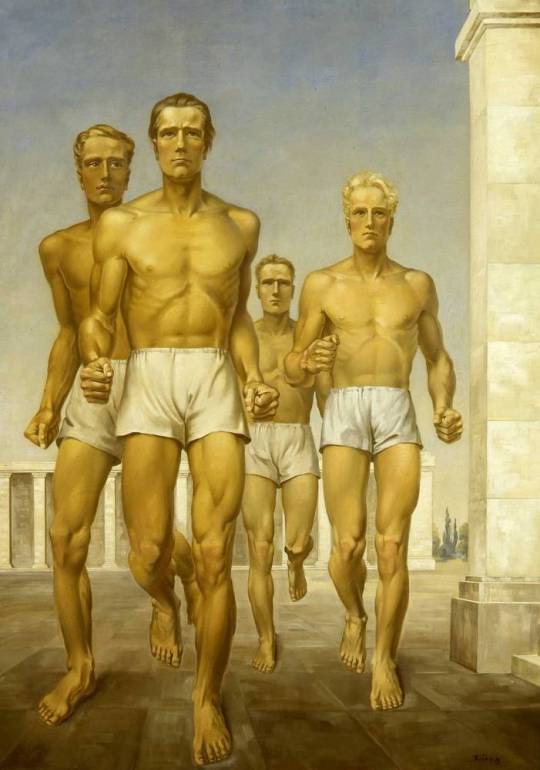

Gerhard Keil
Turner
Turnerinnen
1939
Staatliche Kunstsammlungen Dresden
https://www.skd.museum/
149 notes
·
View notes
Text
Über Druck. Zeitgenössische Druckgrafik aus Sachsen und der Lausitz: Görlitz bis 20. 08. 2023
Die Kunst der Druckgrafik erlebt in der Gegenwart eine Wiederentdeckung. Anhand von Radierungen, Holzschnitten, Lithografien, Siebdrucken oder auch Kupferstichen zeigt diese Sonderausstellung, was Künstlerinnen und Künstler aus Sachsen und der Lausitz heute an den traditionsreichen Techniken reizt, welche Bildsujets sie finden und wie die Grenzen zu den neuen digitalen Medien ausgelotet…

View On WordPress
#angewandte Kunst#Überdruck#Druckkunst#Görlitzer Sammlungen#Innovation#Inspiration#Kaisertrutz#Kulturhistorisches Museum#Kunstfonds#Kunstschaffen#Kupferstich#Originalgraphik#Region#Sachsen Lausitz#siebdruck#Staatliche Kunstsammlungen Dresden
0 notes
Photo
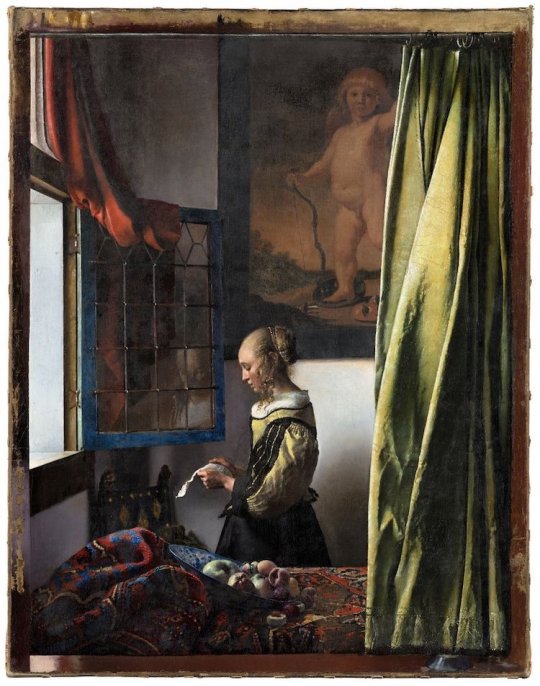
Los cuadros procedentes de Holanda en los que se ve a mujeres leyendo cartas junto a una ventana las representan ausentes del mundo en el que , no obstante, están, de pie, plantadas orgullosamente, con una maravillosa prestancia. Tienen la piel muy blanca. Por encima de las cejas y sobre el puente de la nasal, la piel es por decirlo así transparente. El haz de luz de la ventana hacia la que están vueltas difumina la limpidez, la delicadeza, el relieve de sus semblantes.
Les encanta el sol.
Es la estrella que creó este mundo lo que admiran al fondo del cielo azul. Lucen unos moños sublimes. Son como dalias, como cardos bañados por el sol. De pronto, la superficie de su frente aumenta porque la inclinan hacia el papel que tienen desplegado entre las manos: ahí está el verdadero tesoro. No está al otro lado del vidrio, está entre sus dedos. El papel que despliegan, que están leyendo, siguiéndolo con el dedo.
En realidad, se han ausentado del refinado entorno, la espineta, el tapete sobre la mesa, el espejo, los cuadros expuestos en la pared.
Han entrado en la espesura del deseo que sueñan.
Ahora están soñando con un hombre.
Que bellas son estas jóvenes junto a la ventana cerrada al estrépito de la calle y al rumor del mundo.
Al fondo del amor hay un impulso extraordinario, que disuelve completamente el estado anterior y que es tan poderoso que logra devastar la memoria de la infancia.
Minúsculas letras en la página, que desasosiegan a quien las lee y las relee y la enrolla entre las manos.
Que la enrolla maquinalmente.
Que, de nuevo, con precaución , la desenrolla, la vuelve a leer.
Resulta que, aunque compartan el lecho, la mujer y el hombre no sueñan la mismo.
¿Quién puede confiar su vida a los brazos que un día lo abandonaron?
- El amor el mar, Pascal Quignard.
Galaxia Gutenberg 2023. Traducción del francés de Ignacio Vidal-Folch.
Muchacha leyendo una carta por Johannes Vermeer. 1657-1659. (Foto: Staatliche Kunstsammlungen Dresden / Wolfgang Kreische)
41 notes
·
View notes
Text

Judas Ischarioth, 1923, de Sascha Schneider. Staatliche Kunstsammlungen Dresden.
8 notes
·
View notes